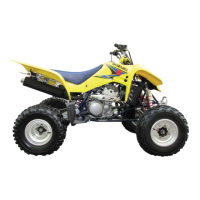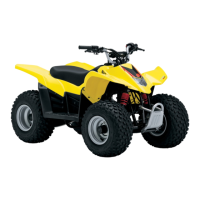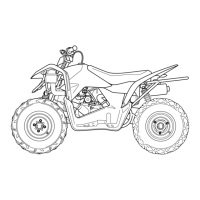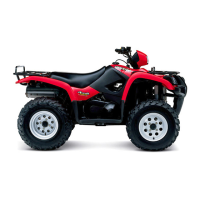BRAKE FLUID REPLACEMENT
• Place the vehicle
on
a level surface and keep the handlebar
straight.
• R
emove
the master
cy
l
inder
reservoir
cap
and
diaphragm.
•
Suck
up the old brake
ft
uid as much as possible.
• Fill the reservoir with new br
ake
fluid.
~
Specification and
classification:
DOT 4
• Connect a clear hose to the air bleeder
va
l
ve
and insert the
other
end
of
the h
ose
into a receptacle.
• Loosen the air bleeder valve and p
um
p the brake
le
ver un
ti
l
the old brake fluid is completely out of t
he
brake
system.
• Close
the
air bleeder valve and
disconnect
the clear
hose
. Fill
the reservoir
wi
th new brake
fl
ui
d to the upper end of the
inspection window.
~
Brake air bleeder valve: 7.5 N·m
(0
.75
kgf-m
. 5.5
Ib
-ft)
I
CAUTION
I
* Never reuse the brake
fluid
left
over
from
previous
servicing
and
which
has
been
stored
for
long
peri-
ods
of
time
.
* Bleed
air
from
the brake system.
(
c:7
2-19)
BRAKE CALIPER REMOVAL AND
DISASSEMBLY
• Remove the front wheel. (
c:::7'
6-10)
•
Disconnect the brake hose from the brake caliper by remov-
ing the brake hose union bolt
G)
and all
ow
the brake
flu
id to
drain into a suitable
raceptacle.
•
Remove the brake caliper
by
removing
the
brake caliper
moun
ti
ng bolts
(2).
• Remove the brake pads. (
0'"
6-18)
A WARN1NG
Brake
fluid
,
if it
leaks, will Interfere
with
safe
running
and
discolor
painted surfaces. Check
the
brake
hose
,
brake pipe and
hose
joints
for
cracks
and leakage
of
brake
fluid
.
CHASSIS
6-19

